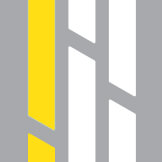Painting (coating) and decorative cladding of building facades
is considered in our view a complementary and final process to the primary process of concrete rehabilitation and restroration.
However, even though it is “merely” a decorative process, it incorporates material and finishing systems that enable the client to extend the service life of the building and to improve the structure’s long-term maintenance regime.
The range of decorative options offered to the customer as a final finishing is broad. The following is a description of most of the solutions and systems that are applied in the Israeli market:
The plaster system constitutes a thick (5-50 mm) cement-based coat for existing concrete. Beside its decorative function as a finishing system for evening outs bumps and curvatures on the concrete surface, its other function is to provide a solid base for the finishing decorative systems (coat, cladding or paint). At Reshef, we view the plaster system as key for prolonging the service life of the building and for the success of the project. Therefore we implement durable plaster systems that are approved for marine environment in accordance with Israel Standard 1920Such plaster systems are characterized by better than normal bond strength, in ready-to-use mixtures without adding aggregates or cement (to prevent introduction of salts that might accelerate corrosion). In some cases, we will even add a latex additive to improve the adhesion and seal of the plaster system.
Two-Stage Industrial Paint System
“The Rolls Royce of Paint”
This system enables extension of the service life or building facades and concrete elements for years.
The coating provides buildings in areas of enhanced corrosion (such as the coastline) protection and resistance to salts, various chemicals and full UV protection.
The coat system consists of a two components: an epoxy-based primer that bonds to the existing surface and a two-part UV-resistant polyurethane top coat.
Mixing Part A and Part B of the top coat is critical for the proper application of the coat. The system is characterized by long-lasting durability in a corrosive environment in accordance with corrosion and concrete rehabilitation and has high permeability (optimal sealing and penetration) that actually seals building facades. The applied system’s thickness is approximately 180-220 microns and most manufacturers offer matte/silk/fine textures in their RAL shade fans. The type of texture affects the maintenance of the facades and the ability to wash them with water.
*Industrial coatings systems for concrete are modular and vary according to a wide range of product, and therefore multiple solutions can be adapted to respond to the specification of the coating system.
Application and inter-system integration processes critically affect the project’s success.
Combining concrete rehabilitation systems with the great variety of plaster and decorative finishing systems requires the use of material systems that correspond to one another in order to enable continuity between systems without failures between systems.
Therefore, every project requires a complete and broad specification that specifies the systems and their bonding, including curing times, types of applied paint families, types of adhesives and the time interval (window time) between one system and another.
**In the Cladding Installation and Reinforcement section, we will elaborate on decorative solutions of dry cladding systems.

